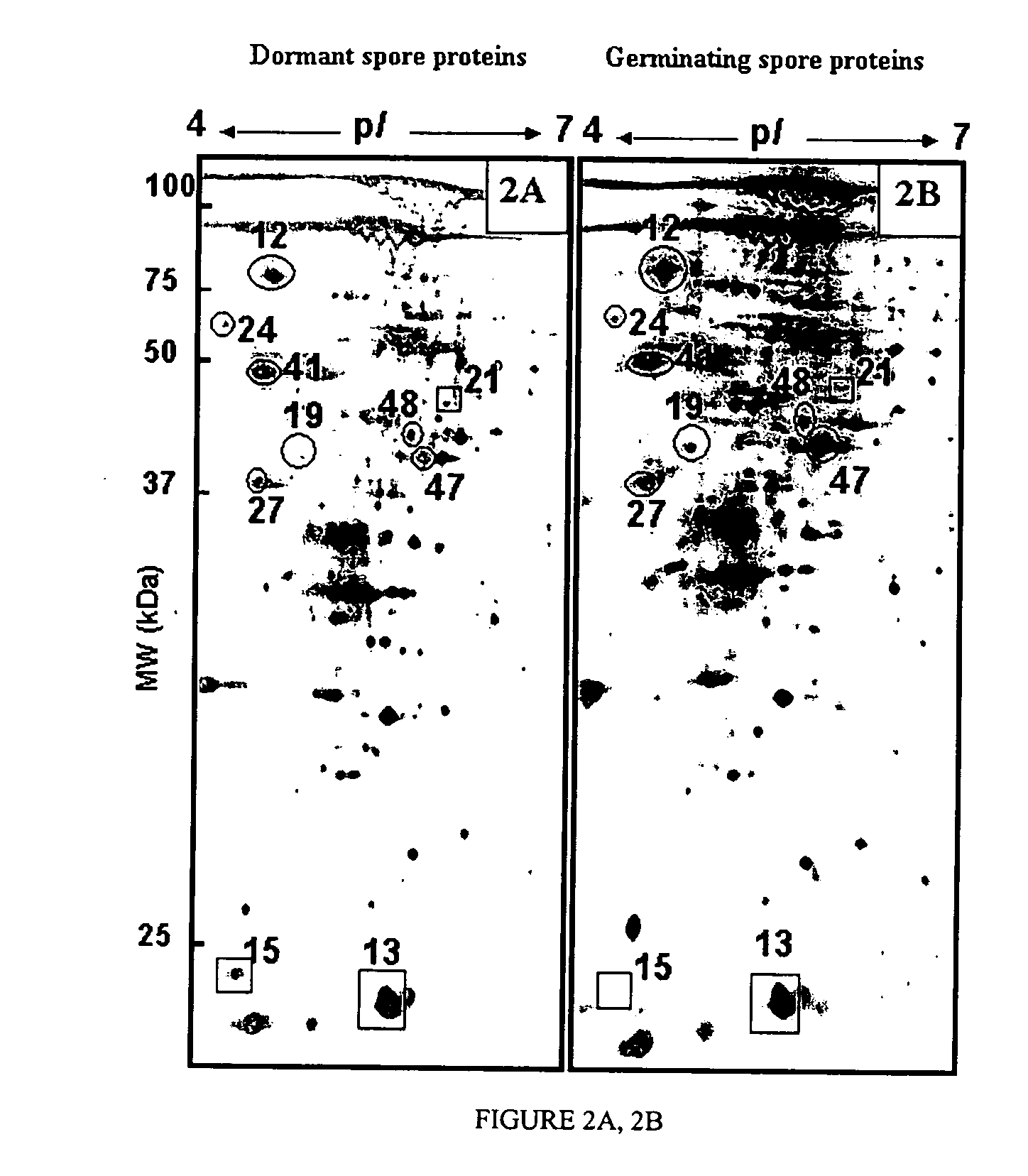Novel targets and compositions for use in decontamination, immunoprophylaxis, and post-exposure therapy against anthrax
a technology of immunoprophylaxis and anthrax, applied in the field of bacteriaology, immunology, vaccine technology, can solve the problems of no convincing data to suggest, edema and tissue necrosis but little or no purulence, and spread of airborne spores in a populated area
- Summary
- Abstract
- Description
- Claims
- Application Information
AI Technical Summary
Benefits of technology
Problems solved by technology
Method used
Image
Examples
example 1
Characterization of Germination of Bacillus anthracis Spores
[0130] Dormant spores of Bacillus anthracis Sterne strain were heated at 65° C. for 30 min prior to growth in medium for 2 days at 37° C. with shaking. Aliquots of samples were removed periodically for spectrophotometric analysis (OD560) and the results were plotted as a growth curve characterizing the spore germination stage (FIGS. 1A and 1B). The decline in OD560 for the first 15 min (FIG. 2b) is recognized as germinating stage (Welkos, S. et al., Microbiology 147:1677-1685, 2001).
[0131] Microscopic validation of spore germination was also performed. Purified dormant spores and spores with germination and early outgrowth induced at 37° C. in medium for 10 min, respectively, were fixed in 10% buffered formalin, dried, and viewed on a Zeiss Axioskop2 plus microscope using a 100×oil immersion lens.
example 2
Proteomic Profiling of Bacillus anthracis Spores
[0132] Proteomic profiling of Bacillus anthracis dormant and germinating spores was used to reveal a number of spore proteins.
[0133]Bacillus anthracis spores were prepared as previously described (Steichen, C. et al., J Bacteriol 185:1903-1910, 2003). Total protein was extracted from dormant and germinating spores as described (Huang 2003). Aliquots containing 300 μg protein were mixed 1:1 with rehydration solution containing 7 M urea, 2 M thiourea, 4% CHAPS, 2% SB 3-10, 5 mM tri-butylphosphine, 1.6% pH 5-8 Bio-lytes, 0.4% pH 3-10 Bio-Lytes, and trace bromophenol blue. Samples were subjected to isoelectricfocusing (IEF) in 13-cm linear gradient Immobiline Dry-Strips, pH 4-7, at 60 kVh using a Pharmacia Hoefer Multiphor II electrophoresis chamber.
[0134] Following IEF, Dry-Strips were incubated at room temperature for 20 min in equilibration solution containing 50 mM Tris-HCl, pH 8.8, 6 M urea, 2% sodium dodecyl sulfate (SDS), 30% gly...
example 3
Determination of Germination / Outgrowth-Associated Proteins
[0141] Germination / outgrowth-associated proteins were revealed by subtracting background proteins in dormant spores. The protein samples from dormant spores (time 0, FIG. 2A) and germinating stage (10 min, FIG. 2B) were subjected to IEF within linear pH gradients ranging from 4-7 followed by 2-DE and silver-staining. Using MALDI-TOF MS in conjunction with a probability-based database searching algorithm, 10 proteins were recognized to display increase or decreases during the germinating stage. The protein spots were quantified using PDQuest software (Bio-Rad, Hercules, Calif.). All germination / outgrowth-stage protein spots showing a statistically significant increase or decrease (defined as greater than 30% change in comparison to those in dormant spores) were selected for further analysis.
[0142] To further identify protein spots, spots were cut from the silver-stained gels and in-gel digested with the trypsin enzyme. The d...
PUM
| Property | Measurement | Unit |
|---|---|---|
| Fraction | aaaaa | aaaaa |
| Electric charge | aaaaa | aaaaa |
| Current | aaaaa | aaaaa |
Abstract
Description
Claims
Application Information
 Login to View More
Login to View More - R&D
- Intellectual Property
- Life Sciences
- Materials
- Tech Scout
- Unparalleled Data Quality
- Higher Quality Content
- 60% Fewer Hallucinations
Browse by: Latest US Patents, China's latest patents, Technical Efficacy Thesaurus, Application Domain, Technology Topic, Popular Technical Reports.
© 2025 PatSnap. All rights reserved.Legal|Privacy policy|Modern Slavery Act Transparency Statement|Sitemap|About US| Contact US: help@patsnap.com



